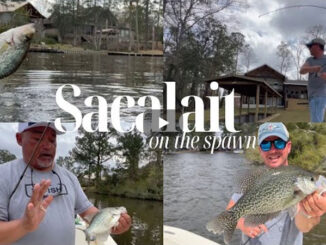
Work the flats and submerged timber slowly
During a lengthy law enforcement career, Jay Kavanaugh of Ruston spent a lot of time patrolling important areas of Lincoln Parish. Now he has traded that in for doing the same thing on area lakes. This time of year, you’ll find him on regular patrol out on the flats of Lake D’Arbonne in search of big post-spawn crappie.
“This is the time of year that a lot of people stop fishing because the fish are moving out of shallow water and spreading out,” Kavanaugh said. “But that certainly doesn’t mean you have to stop catching crappie.”
Depending on water temperatures, most of the fish start moving out into the numerous 12-14 foot deep “flats” on the lake. It takes the fish a few days to get over the spawn, but then they are hungry again and that’s when Kavanaugh moves in.
“You won’t find the fish stacked up like they are in the channels during cold weather, but they move out on the flats and hang around the submerged timber,” Kavanaugh said. “When they built D’Arbonne, they didn’t cut the timber. They just flooded it. So most of the flats have stumps and the fish hang out there.”
As the flat fishing heats up this month, Kavanaugh uses his electronics to locate areas with fish and he works them slowly with jigs. He usually fishes about 6-10 feet deep, based on where his electronics are showing him fish.
“You can spider rig, but I rarely put out more than four poles because you are going to get hung up,” he said. “That’s just part of it. The easiest way to avoid hanging up is to single pole, or hold one pole in each hand. That way you feel it when your jig bumps a stump. One thing I do when spider rigging is put a half-ounce egg weight up my line above the jig. Most of the time when you hook a stump, you can drop that egg weight and knock your jigs loose.”
Kavanaugh likes two Bobby Garland jig colors this time of year that are on opposite ends of the spectrum. He fishes Vegas, a dark red color, and Blue Thunder, a lighter blue, shad type color. He also uses 8-pound test line so he can often pull jigs loose when they get hung.
“This is one of my favorite times of the year to fish,” he said. “You just slowly work the flats and submerged timber. Usually you sit still, but sometimes you have to use your trolling motor and move the baits .3 or .5 miles per hour to get them to hit.”


